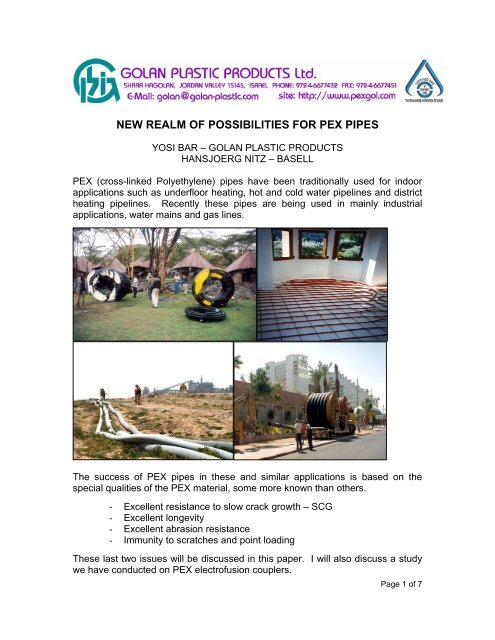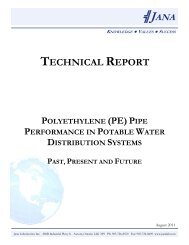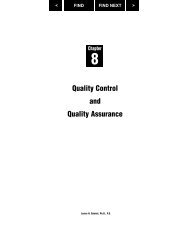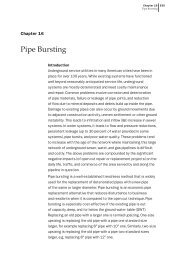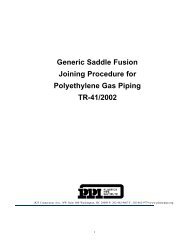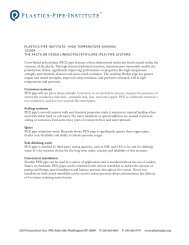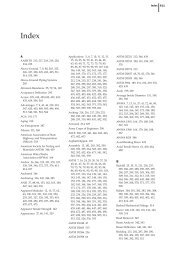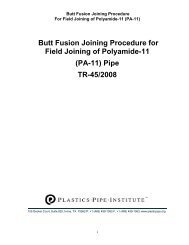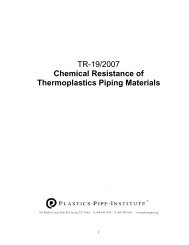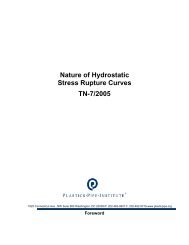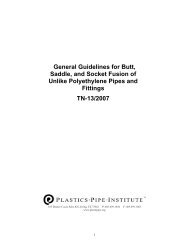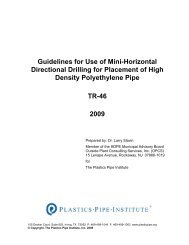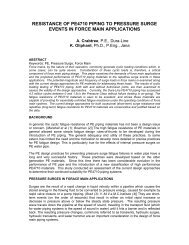new realm of possibilities for pex pipes - Plastics Pipe Institute
new realm of possibilities for pex pipes - Plastics Pipe Institute
new realm of possibilities for pex pipes - Plastics Pipe Institute
You also want an ePaper? Increase the reach of your titles
YUMPU automatically turns print PDFs into web optimized ePapers that Google loves.
NEW REALM OF POSSIBILITIES FOR PEX PIPES<br />
YOSI BAR – GOLAN PLASTIC PRODUCTS<br />
HANSJOERG NITZ – BASELL<br />
PEX (cross-linked Polyethylene) <strong>pipes</strong> have been traditionally used <strong>for</strong> indoor<br />
applications such as underfloor heating, hot and cold water pipelines and district<br />
heating pipelines. Recently these <strong>pipes</strong> are being used in mainly industrial<br />
applications, water mains and gas lines.<br />
The success <strong>of</strong> PEX <strong>pipes</strong> in these and similar applications is based on the<br />
special qualities <strong>of</strong> the PEX material, some more known than others.<br />
- Excellent resistance to slow crack growth – SCG<br />
- Excellent longevity<br />
- Excellent abrasion resistance<br />
- Immunity to scratches and point loading<br />
These last two issues will be discussed in this paper. I will also discuss a study<br />
we have conducted on PEX electr<strong>of</strong>usion couplers.<br />
Page 1 <strong>of</strong> 7
ABRASION RESISTANCE OF PEX PIPES<br />
PE <strong>pipes</strong> are frequently used <strong>for</strong> the transportation <strong>of</strong> fish food to the marine<br />
cages where fish are raised. The fish food is very abrasive and while PE is very<br />
resistant to abrasion, in this severe application the PE <strong>pipes</strong> are soon worn out.<br />
Several fish raising companies have tried PEX <strong>pipes</strong>, including Chilean and<br />
Israeli companies. One Israeli company had found out that the PE <strong>pipes</strong> were<br />
able to transport 300 tons <strong>of</strong> fish food be<strong>for</strong>e they were finished, while the PEX<br />
<strong>pipes</strong> transported over 1000 tons – a threefold increase.<br />
Red Sea – Fish Food Transportation<br />
In the gold mines <strong>of</strong> South Africa, the ores are fed back into the mine to serve as<br />
supporting columns. This is called “back fill”. The feeding is done by gravity.<br />
The line velocity is enormous, 6-8 mtrs/second (20 – 26 fps) with very little<br />
abrasion. PEXGOL <strong>pipes</strong> were tested as a replacement <strong>for</strong> PE <strong>pipes</strong>. The test<br />
was commissioned by “Western Deep Levels” which is the deepest gold mine<br />
owned by the Anglo America. The test was done by the consulting company ,<br />
“Patterson & Cooke” (Report no. WPR-018.R13 from August 1994). The results<br />
were that PEXGOL <strong>pipes</strong> were 3 times better in abrasion resistance compared to<br />
HDPE. The difference is more pronounced at higher velocities.<br />
Page 2 <strong>of</strong> 7
In a comparative abrasion test carried out by the raw material supplier, Basell,<br />
PE and PEX <strong>pipes</strong> were tested. In this test, which was carried out at relatively<br />
slow velocities, the PEX <strong>pipes</strong> were 1.8 to 2 time better in abrasion resistance<br />
than PE <strong>pipes</strong>. This is in accordance to the previous observation that the<br />
difference in abrasion resistance between PE and PEX <strong>pipes</strong> is more<br />
pronounced at high velocities.<br />
Abrasion Test Apparatus<br />
0,00<br />
-0,05<br />
-0,10<br />
Medium Abrasion [mm]<br />
-0,15<br />
-0,20<br />
-0,25<br />
-0,30<br />
-0,35<br />
-0,40<br />
PE-Xa after 200.000 Cycles<br />
PE-Xa after 400.000 Cycles<br />
-0,45<br />
PE 100 after 100.000 Cycles<br />
PE 100 after 200.000 Cycles<br />
-0,50<br />
-50 -40 -30 -20 -10 0 10 20 30 40 50<br />
Angle [°]<br />
In the Dead Sea area, there was a problem <strong>of</strong> large salt crystals growing from the<br />
seabed. These crystals were an obstacle to the harvesting operation <strong>of</strong> the<br />
potash from the Dead Sea ponds – which is the heart and core <strong>of</strong> the business <strong>of</strong><br />
Page 3 <strong>of</strong> 7
the “Dead Sea Works”. These crystals had to be disposed <strong>of</strong>. Special dredges<br />
were brought by two companies to cut, grind, and transport them to the seashore<br />
by <strong>pipes</strong>. One <strong>of</strong> the 2 companies, ordered PN10 450mm PEX <strong>pipes</strong> <strong>for</strong><br />
dredging. The other company ordered from the USA special HMW – PE<br />
abrasion resistant <strong>pipes</strong>. The HMW PE <strong>pipes</strong> served <strong>for</strong> 2 months be<strong>for</strong>e being<br />
abraded and replaced by PEX <strong>pipes</strong>. After completing the dredge project, the<br />
PEX <strong>pipes</strong> were resold to another company <strong>for</strong> a different dredging operation and<br />
the <strong>pipes</strong> per<strong>for</strong>med as if they were <strong>new</strong>. PEX <strong>pipes</strong> obviously are the perfect<br />
solution to abrasion!<br />
500mm PEXGOL <strong>Pipe</strong>s <strong>for</strong> Dead Sea Works dredging<br />
POINT LOADING AND SAND BEDDING<br />
What happens if you do not use sand, but rather the native soil as a cover <strong>for</strong> the<br />
<strong>pipes</strong><br />
Point loading is the result <strong>of</strong> compacting sand that contains stones in it.<br />
These stones create tensile stresses at the inner layer <strong>of</strong> the pipe. The result is<br />
failure by the slow crack growth (SCG) mechanism and brittle failures. Since this<br />
is a SCG mode <strong>of</strong> failure, the scientists tried to correlate the failure <strong>of</strong> point<br />
loading to the failure in SCG tests, line the FNCT <strong>for</strong> example.<br />
In FNCT, the specimen is a square rod bar made <strong>of</strong> the pipe material. A sharp<br />
notch is made in the centre <strong>of</strong> the specimen, and it is put under tensile stress <strong>of</strong><br />
4MPa inside detergent in 80 degrees C. This test was conducted by the German<br />
company <strong>of</strong> Dr. Hessel. The time to failure <strong>of</strong> PEX <strong>pipes</strong> is naturally the<br />
maximum as compared to various PE resins. When correlating the FNCT test<br />
with the point loading times to failure, the result was a very good correlation.<br />
Since there is much data regarding FNCT, it was possible to analyze it and to<br />
conclude that it is possible to use PEX <strong>pipes</strong> without sand embedding.<br />
Page 4 <strong>of</strong> 7
Open installation with reutilisation <strong>of</strong> excavated soil<br />
Stones on PEX pipe<br />
ASSESSMENT OF THE LONG TERM PROPERTIES OF HOT WATER<br />
ELECTROFUSION FITTINGS<br />
The long term properties <strong>of</strong> electr<strong>of</strong>usion fittings depend on the raw material<br />
properties. This is true <strong>for</strong> any type <strong>of</strong> fittings as it is true <strong>for</strong> any type <strong>of</strong> pipe.<br />
But there are other significant factors which have a significant effect on the<br />
lifetime <strong>of</strong> the fitting and these factors are usually not looked at in the case <strong>of</strong> a<br />
pipe. One factor is the fitting design. In the case <strong>of</strong> a pipe, this is actually the<br />
SDR value <strong>of</strong> the pipe. In case <strong>of</strong> a fitting, in addition to that, the shape <strong>of</strong> the<br />
fitting creates additional stresses. It is obvious that the stress regime in a T piece<br />
is not the same stress as that <strong>of</strong> a straight coupler or an elbow. The result is a 3<br />
dimensional stress tensor which has to be carefully looked at.<br />
One common stress concentration factor in all electr<strong>of</strong>usion couplers is the<br />
central cold zone. Other places are the corners <strong>of</strong> a T or elbow fittings, which<br />
Page 5 <strong>of</strong> 7
tend to become straight at high stresses. In our study, we tested PEX<br />
electr<strong>of</strong>usion fittings. The raw material was TUX 100 by Solvay.<br />
The fittings which were tested were:<br />
- Straight couplers<br />
- Tees<br />
- Elbows<br />
In previous tests, the straight couplers having SDR 7.4 were approved as<br />
equivalent to SDR 11 PEX <strong>pipes</strong> (according to ISO 15875 part 3 and 5). The test<br />
purpose was to see whether it is possible to use these fittings without precrosslinking<br />
them. The fittings were tested at a pressure <strong>of</strong> 9.9 bars. According<br />
to the regression curves <strong>of</strong> TUX 100, this is the “working pressure” <strong>of</strong> this fitting .<br />
The result was that the fitting failed after only 282 hours. Another fitting <strong>of</strong> the<br />
same production was first pre-crosslinked in a hot water bath with no pressure.<br />
Then it was put to test at a higher test pressure <strong>of</strong> 13.4 bars. The fitting failed<br />
after 1130 hours.<br />
In both cases, the failure was in the sharp corner between the central outlet and<br />
the side outlet.<br />
Conclusions:<br />
- The fittings should be pre-crosslinked in order to increase their lifetime<br />
- The fitting should be redesigned in order to reduce the stressconcentration<br />
factor<br />
Page 6 <strong>of</strong> 7
Yosi Bar – R&D Manager<br />
Golan Plastic Products<br />
Jordan Valley 15145<br />
Israel<br />
Phone: 972 4 66 77 652<br />
e-mail: yosibar@golan-plastic.com<br />
Dr. Hansjoerg Nitz<br />
Technical Manager<br />
Basell Polyolefine GmbH<br />
Industriepark Hochst, C 657<br />
65926 Frankfurt (M)<br />
Germany<br />
Phone: 49 69 305 161 80<br />
e-mail: hansjoerg.nitz@basell.com<br />
Page 7 <strong>of</strong> 7


